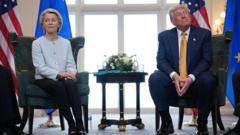European Union negotiators are grappling with dissatisfaction following the recent announcement of a trade agreement with the United States, brokered by European Commission chief Ursula von der Leyen and US President Donald Trump after prolonged discussions. Although the agreement, featuring a 15% tariff on most EU exports, is a relief compared to the initially threatened 30%, it nonetheless leaves many details unsettled and has sparked criticism from various EU member states.
Germany's Finance Minister Lars Klingbeil voiced disappointment at the lack of a firmer stance during negotiations, noting, “I would have wished for a different outcome." While acknowledging the agreement offers a degree of certainty amid the turmoil, he highlighted concerns over the tariffs imposed on industries. The European Commission has yet to issue a joint statement, clarifying that the current outline represents political commitments rather than legally binding targets.
Different interpretations of the agreement have exacerbated disparities between the EU and the US. The US is quoting tariffs for pharmaceuticals and semiconductors, while the EU asserts they will maintain the current 0% rate until a global consensus on tariffs is reached. Similarly, discrepancies surrounding investment commitments reveal the complexities of reconciling terms that differ significantly between both sides.
With France’s President Emmanuel Macron characterizing the agreement as “the first step,” European leaders recognize it as the beginning of a renewed negotiating process likely to unfold over the next few years. Key sectors, especially automotive, pharmaceutical, and agricultural industries in Germany, Ireland, and Italy stand to be disproportionately affected. Irish leaders expressed mixed feelings regarding the agreement, stating, “It is what it is and we move on.”
Italian stakeholders highlighted that the new tariffs could significantly impact the economy, predicting a 0.2% decline in GDP. Trade associations in Italy are now calling for compensation measures, sparking debates over the financial implications for EU taxpayers. According to experts, a rush to provide extensive benefits to EU exporters would inadvertently validate trade policies that place the burden on European industries.
As negotiations unveil the differing visions of what the trade relationship should look like, member states will grapple with their positions within this evolving landscape.



















